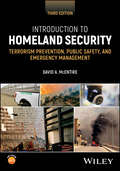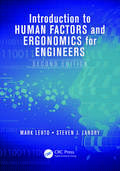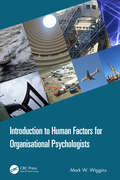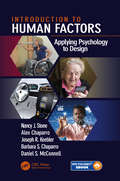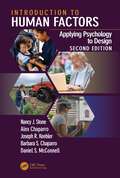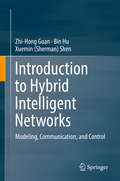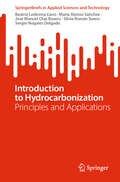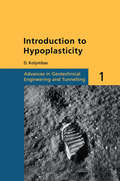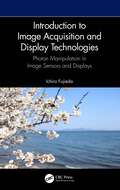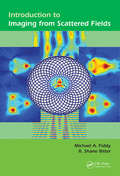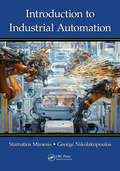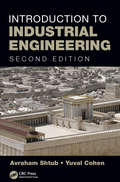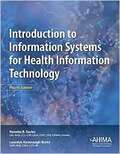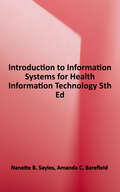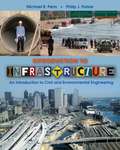- Table View
- List View
Introduction to Homeland Security: Terrorism Prevention, Public Safety, and Emergency Management
by David A. McEntireExplore the growing concerns about security with this vital book Homeland Security has never been a more important part of the American social and political fabric. Risk assessment, attack prediction and prevention, preparedness measures, response to terrorist activity, and natural disaster management all fall under the purview of homeland security. It is a key focus of the US security state, which has expanded massively in recent decades. Introduction to Homeland Security provides an overview of this subject for professors, students, and practitioners in the field. Drawing upon a rich foundation of scholarship and academic literature, it focuses principally on terrorism prevention and protection, and offers new content related to novel threats and security concerns. Its practitioner-centered approach and attention to both governmental and non-governmental stakeholders make it an indispensable introduction to the subject. Readers will also find: Coverage of the four traditional phases of emergency management New and additional treatment of border control, drug trafficking, organized crime, mass shootings, protests, riots, pandemics, and climate change Companion websites including extensive pedagogical materials, student self-assessment tests, and an image gallery Introduction to Homeland Security is ideal for professors and students in homeland security and emergency management programs, as well as practitioners involved in this important profession.
Introduction to Human Factors and Ergonomics
by Robert BridgerBuilding on the success of previous editions, the 4th edition of ‘Introduction to Human Factors and Ergonomics’ provides a comprehensive and up to date introduction to the field. The new edition places the subject matter into a system context using a human-machine model to structure the chapters and a knowledge application model to structure the organisation of material in each chapter. Every chapter covers: Core Concepts, Basic Applications, Tools and Processes, and System Integration issues regardless of topic. Includes over 200 exercises and essays (at least ten per chapter). An Instructor’s Manual, A Guide to Tutorials and Seminars and and over 500 powerpoint slides are available for academic users from the publisher. All chapters contain ‘HFE Workshop’ sections with practical guidance and worked examples. Please see the TOC for more information.
Introduction to Human Factors and Ergonomics for Engineers (Human Factors and Ergonomics)
by Mark R. Lehto Steven J. LandryWith a practical, applied orientation, this book presents and integrates in a single source important methods and tools used in the fields of industrial engineering, human factors and ergonomics to design and improve jobs, tasks and products. The author covers such topics as the human system, motion analysis, predicting human performance, simulation in ergonomic design, product quality and usability, macroergonomics, and occupational safety and health. Each chapter offers challenging problems and examples to illustrate concepts. The new second edition features two new chapters that address human error causation and reduction and human computer interaction. It also includes updated figures.
Introduction to Human Factors and Ergonomics, Fifth Edition
by R S BridgerErgonomics and human factors impact how humans interact with the world around them. Understanding these factors can be difficult. To cut through the tricky aspects of the subject, this bestselling textbook offers a comprehensive and up-to-date introduction to the field. This title places the subject matter into a system context using a human-machine model to structure the chapters and a knowledge application model to structure the organisation of material in each chapter.Every chapter covers Core Concepts, Basic Applications, Tools and Processes, and System Integration issues regardless of topic. This updated fifth edition provides new material on current occupational health issues such as obesity, menopause, and other modern work-related medical concerns. Updated to include coverage of new technological developments such as self-driving cars, exoskeletons, AI, hybrid working and cell phone ergonomics. Examples where tools are used including the Strain Index and the Lifting Fatigue Failure Tool have been fully updated, featuring signposting to additional resources and toolkits. Readers will grasp a full and thorough grounding in the need-to-knows of ergonomics and human factors.Introduction to Human Factors and Ergonomics, Fifth Edition is the premier textbook for any student where ergonomics and human factors play a part in their discipline, including those in aviation, medicine and healthcare, energy, engineering, health and safety and the sciences.Also included in this updated new edition are an instructor’s manual and a guide to tutorials and seminars. Over 500 PowerPoint slides are available for academic use from the publisher.
Introduction to Human Factors for Organisational Psychologists
by Mark W. WigginsThis text introduces industrial and organisational psychologists to the discipline of human factors. It also provides a range of tools necessary for the application of human factors strategies and techniques in practice. The text is intended to respond to the growing demand for organisational psychologists to assist in the development and evaluation of initiatives that are intended to optimise the relationship between workers and the operational environments with which they engage. The book • Contains practical strategies and examples that are intended to guide readers • Combines human factors and organisational psychological concepts in a single volume • Covers context-related examples that illustrate the application of human factors tools and principles • Presents an integrated approach to human factors from an organisational psychological perspective The text begins by discussing the application of human factors in organisations, together with notions of risk and uncertainty. Frameworks for human factors are considered, including error-based and system safety approaches. It explores the links between individual differences and human factors, and it covers group processes and the impact on team performance, including the role of leadership and followership. The book also presents a range of tools and techniques that can be applied by organisational psychologists to acquire human factors-related information and develop an understanding of the situation or factors that may explain human behaviour.
Introduction to Human Factors: Applying Psychology to Design
by Nancy J. Stone Alex Chaparro Joseph R. Keebler Barbara S. Chaparro Daniel S. McConnellThis is a comprehensive, but accessible text that introduces students to the fields of human factors and ergonomics. The book is intended for undergraduate students, written from the psychological science perspective along with various pedagogical components that will enhance student comprehension and learning. This book is ideal for those introductory courses that wish to introduce students to the multifaceted areas of human factors and ergonomics along with practical knowledge the students can apply in their own lives.
Introduction to Human Factors: Applying Psychology to Design, 2nd Edition
by Nancy J. Stone Alex Chaparro Joseph R. Keebler Barbara S. Chaparro Daniel S. McConnellThis textbook comprehensively introduces readers to the cutting-edge field of human factors psychology, offering real-world examples illustrating how experimental findings can be used to improve the design of tools and environments that we use every day. The revised second edition provides updated text, examples, pedagogical boxes, and references.Features: Showcases pedagogical boxes that end with thought questions to encourage student processing and application of the material Includes instructor materials such as PowerPoint slides, activities, and exam items to facilitate teaching for instructors who are new to the course Presents theoretical and practical implications of applying psychology to design with the use of examples Discusses anthropometric tools, anthropometric data collection methods, hand biomechanics, and hand tools Highlights diversity and inclusion with applications to the special population section in each chapter Introduction to Human Factors is an ideal read for senior undergraduate and graduate students in the fields of ergonomics, human factors, and psychology.Online teaching resources accompany this textbook, including PowerPoints, a test bank with answers, and an end-of-chapter questions and answers key for the instructors.
Introduction to Hybrid Intelligent Networks: Modeling, Communication, and Control
by Bin Hu Xuemin Sherman Shen Zhi-Hong GuanThis book covers the fundamental principles, new theories and methodologies, and potential applications of hybrid intelligent networks. Chapters focus on hybrid neural networks and networked multi-agent networks, including their communication, control and optimization synthesis. This text also provides a succinct but useful guideline for designing neural network-based hybrid artificial intelligence for brain-inspired computation systems and applications in the Internet of Things.Artificial Intelligence has developed into a deep research field targeting robots with more brain-inspired perception, learning, decision-making abilities, etc. This text devoted to a tutorial on hybrid intelligent networks that have been identified in nature and engineering, especially in the brain, modeled by hybrid dynamical systems and complex networks, and have shown potential application to brain-inspired intelligence. Included in this text are impulsive neural networks, neurodynamics, multiagent networks, hybrid dynamics analysis, collective dynamics, as well as hybrid communication, control and optimization methods. Graduate students who are interested in artificial intelligence and hybrid intelligence, as well as professors and graduate students who are interested in neural networks and multiagent networks will find this textbook a valuable resource. AI engineers and consultants who are working in wireless communications and networking will want to buy this book. Also, professional and academic institutions in universities and Mobile vehicle companies and engineers and managers who concern humans in the loop of IoT will also be interested in this book.
Introduction to Hydro Energy Systems: Basics, Technology and Operation
by Hermann-Josef Wagner Jyotirmay MathurThe authors have tried to strike a balance between a short book chapter and a very detailed book for subject experts. There are three prime reasons behind for doing so: first, the field is quite interdisciplinary and requires simplified presentation for a person from non-parent discipline. The second reason for this short-version of a full book is that both the authors have seen students and technically oriented people, who were searching for this type of book on hydro energy. The third reason and motivation was considering engineers who are starting their career in hydro energy sector. This book is targeted to present a good starting background and basic understanding for such professionals.
Introduction to Hydrocarbonization: Principles and Applications (SpringerBriefs in Applied Sciences and Technology)
by Sergio Nogales Delgado Beatriz Ledesma Cano María Alonso Sánchez José Manuel Díaz Rasero Silvia Román SueroThe book is a comprehensive exploration of hydrothermal carbonization (HTC), addressing key aspects from its definition and historical relevance to its practical applications and environmental considerations. Throughout its sections, the reader will gain an understanding of the fundamental principles of HTC, including the chemical reactions involved and the catalysts used. In addition, the book provides a comprehensive overview of the various types of waste that can be utilized in the process, from organic sources to industrial and municipal solid wastes. Highlighting the importance in various industries and research areas, case studies illustrating successful applications are presented. A practical perspective is also provided, including exercises for students, exploring laboratory techniques and experiments related to hydrocarbonization. In addition, its focus on research and innovation, addressing current trends and emerging technologies, positions this book as a valuable source for students, researchers, and professionals interested in exploring and developing this field with an emphasis on its potential impact on energy, the environment, and sustainability. The conclusion provides a concise summary of key concepts, a discussion of the future of hydrocarbonization, and an encouragement for students to venture into research in this promising field.
Introduction to Hydrogen Technology
by K. S. Santhanam Roman J. Press Massoud J. Miri Alla V. Bailey Gerald A. TakacsIntroduces the field of hydrogen technology and explains the basic chemistry underlying promising and innovative new technologies This new and completely updated edition of Introduction to Hydrogen Technology explains, at an introductory level, the scientific and technical aspects of hydrogen technology. It incorporates information on the latest developments and the current research in the field, including: new techniques for isolating and storing hydrogen, usage as a fuel for automobiles, residential power systems, mobile power systems, and space applications. Introduction to Hydrogen Technology, Second Edition features classroom-tested exercises and sample problems. It details new economical methods for isolating the pure hydrogen molecule. These less expensive methods help make hydrogen fuel a very viable alternative to petroleum-based energy. The book also adds a new chapter on hydrogen production and batteries. It also provides in-depth coverage of the many technical hurdles in hydrogen storage. The developments in fuel cells since the last edition has been updated. Offers new chapters on hydrogen production, storage, and batteries Features new sections on advanced hydrogen systems, new membranes, greenhouse gas sensors and updated technologies involving solar and wind energies Includes problems at the end of the Chapters, as well as solutions for adopters This book is an introduction to hydrogen technology for students who have taken at least one course in general chemistry and calculus; it will also be a resource book for scientists and researchers working in hydrogen-based technologies, as well as anyone interested in sustainable energy.
Introduction to Hypoplasticity: Advances in Geotechnical Engineering and Tunnelling 1
by D. KolymbasThis book aims to give the reader a short, tractable and as far as possible complete introduction to the young theory of hypoplasticity, which is a new approach to constitutive modelling of granular media in terms of rational continuum mechanics.
Introduction to Image Acquisition and Display Technologies: Photon manipulation in image sensors and displays
by Ichiro FujiedaIn this valuable reference work, Ichiro Fujieda focuses on the component technologies, device configurations, and operation principles of image acquisition and display technologies and provides detailed use cases to give practical guidance on the various current and potential future applications of these technologies. The technology and the physics behind these devices can be grouped into three categories: optical technology, material science, and semiconductor device technology. This book enables readers to gain an understanding of these three areas in relation to the flow of image information and several example applications of the technology. Fujieda first describes the building blocks of image sensors and displays (detectors, light sources, transistors, and wavefront control devices) and their configurations, operation principles, and characteristics. He then describes in more detail image sensor technology (including MOS image sensors, CCD technologies, and X-ray and infrared imagers) and displays (including thin-film transistor arrays, LCDs, OLEDs, MEMS devices, and more). Finally, he provides real-world examples of how these technologies are used together to give the reader an understanding of their practical applications and their potential use in future devices. Some important laws in optics and definitions in color science are included for easy reference. Through this approach, the reader will gain a detailed understanding of each of the component parts of existing imaging devices and will be able to apply this to future developments within the field. This book will benefit any advanced undergraduate and graduate student and industry professional who wishes to expand his or her understanding of the hardware handling digital images. Some basic knowledge is required on semiconductor device physics and the interaction of radiation with matter, though these are described in the appropriate sections.
Introduction to Image Processing and Analysis
by John C. Russ J. Christian Russ<p>Image processing comprises a broad variety of methods that operate on images to produce another image. A unique textbook, Introduction to Image Processing and Analysis establishes the programming involved in image processing and analysis by utilizing skills in C compiler and both Windows and MacOS programming environments. The provided mathematical background illustrates the workings of algorithms and emphasizes the practical reasons for using certain methods, their effects on images, and their appropriate applications. The text concentrates on image processing and measurement and details the implementation of many of the most widely used and most important image processing and analysis algorithms. <p>Homework problems are included in every chapter with solutions available for download from the CRC Press website. The chapters work together to combine image processing with image analysis. The book begins with an explanation of familiar pixel array and goes on to describe the use of frequency space. Chapters 1 and 2 deal with the algorithms used in processing steps that are usually accomplished by a combination of measurement and processing operations, as described in chapters 3 and 4. The authors present each concept using a mixture of three mutually supportive tools: a description of the procedure with example images, the relevant mathematical equations behind each concept, and the simple source code (in C), which illustrates basic operations. In particularly, the source code provides a starting point to develop further modifications. <p>Written by John Russ, author of esteemed Image Processing Handbook now in its fifth edition, this book demonstrates functions to improve an image's of features and detail visibility, improve images for printing or transmission, and facilitate subsequent analysis.</p>
Introduction to Imaging from Scattered Fields
by Michael A Fiddy R. Shane RitterObtain the Best Estimate of a Strongly Scattering Object from Limited Scattered Field DataIntroduction to Imaging from Scattered Fields presents an overview of the challenging problem of determining information about an object from measurements of the field scattered from that object. It covers widely used approaches to recover information about th
Introduction to Industrial Automation
by Stamatios Manesis George NikolakopoulosThis book provides an extended overview and fundamental knowledge in industrial automation, while building the necessary knowledge level for further specialization in advanced concepts of industrial automation. It covers a number of central concepts of industrial automation, such as basic automation elements, hardware components for automation and process control, the latch principle, industrial automation synthesis, logical design for automation, electropneumatic automation, industrial networks, basic programming in PLC, and PID in the industry.
Introduction to Industrial Engineering (Systems Innovation Book Series)
by Avraham Shtub Yuval CohenA Firsthand Look at the Role of the Industrial EngineerThe industrial engineer helps decide how best to utilize an organization’s resources to achieve company goals and objectives. Introduction to Industrial Engineering, Second Edition offers an in-depth analysis of the industrial engineering profession. While also providing a historical perspective chronicling the development of the profession, this book describes the standard duties performed, the tools and terminologies used, and the required methods and processes needed to complete the tasks at hand. It also defines the industrial engineer’s main areas of operation, introduces the topic of information systems, and discusses their importance in the work of the industrial engineer. The authors explain the information system concept, and the need for integrated processes, supported by modern information systems. They also discuss classical organizational structures (functional organization, project organization, and matrix organization), along with the advantages and disadvantages of their use. The book includes the technological aspects (data collection technologies, databases, and decision-support areas of information systems), the logical aspects (forecasting models and their use), and aspects of principles taken from psychology, sociology, and ergonomics that are commonly used in the industry. What’s New in this Edition:The second edition introduces fields that are now becoming a part of the industrial engineering profession, alongside conventional areas (operations management, project management, quality management, work measurement, and operations research). In addition, the book: Provides an understanding of current pathways for professional development Helps students decide which area to specialize in during the advanced stages of their studies Exposes students to ergonomics used in the context of workspace design Presents key factors in human resource management Describes frequently used methods of teaching in the field Covers basic issues relative to ergonomics and human–machine interface Introduces the five basic processes that exist in many organizations Introduction to Industrial Engineering, Second Edition establishes industrial engineering as the organization of people and resources, describes the development and nature of the profession, and is easily accessible to anyone needing to learn the basics of industrial engineering. The book is an indispensable resource for students and industry professionals.
Introduction to Industrial Internet of Things and Industry 4.0
by Sudip Misra Chandana Roy Anandarup MukherjeeIndustrial IoT (IIoT) and Industry 4.0 are newly developing and fast emerging domains of interest among students, researchers, and professionals in academia and industry. Due to the popular demand of this topic, Introduction to Industrial Internet of Things and Industry 4.0 is written to serve a diverse readership from the domains of computer science and engineering, mechanical engineering, information technology, industrial engineering, electronics engineering, and other related branches of engineering. Based on the lead author’s massive open online courses (MOOCs), this book can be used as a textbook on the emerging paradigm of Industry 4.0 and IIoT, as well as a reference for professionals working in sectors of IIoT. The book covers the significant aspects of IIoT in detail, including sensors, actuators, data transmission, and data acquisition, which form the core of IIoT. Topics and concepts are presented in a comprehensive manner, so that readers can develop expertise and knowledge. The book helps beginners to gain a basic idea of Industry 4.0 and IIoT as the first section is an overview of IoT applications, infrastructure-based protocols, cloud computing, and fog computing. The second section is designed to impart a basic knowledge of Industry 4.0 and IIoT as well as of the different phases of development in industry. Delving into more advanced areas, other sections in the book cover: The business models and reference architecture of IIoT The technological aspects of Industry 4.0 and IIoT Predictive and prescriptive analytics applied in IIoT-based implementations Applications and case studies of IIoT Key enabling technologies of IIoT To aid students and professional master IIoT and Industry 4.0, the book includes conceptual questions, exercises, and learning objectives.
Introduction to Industrial Polypropylene
by Dennis B. Malpass Elliot BandThis introductory text is an important resource for new engineers, chemists, students, and chemical industry personnel to understand the technical aspects of polypropylene which is the 2nd largest synthetics polymer in manufactured output. The book considers the following topics:What are the principal types of polypropylene and how do they differ? What catalysts are used to produce polypropylene and how do they function? What is the role of cocatalysts and how have they evolved over the years? How are industrial polypropylene catalysts tested and the resultant polymer evaluated? What processes are used in the manufacture of polypropylene? What are the biopolymer alternatives to polypropylene? What companies are the major industrial manufacturers of polypropylene? What is the environmental fate of polypropylene?
Introduction to Infinite-Dimensional Systems Theory: A State-Space Approach (Texts in Applied Mathematics #71)
by Hans Zwart Ruth CurtainInfinite-dimensional systems is a well established area of research with an ever increasing number of applications. Given this trend, there is a need for an introductory text treating system and control theory for this class of systems in detail. This textbook is suitable for courses focusing on the various aspects of infinite-dimensional state space theory. This book is made accessible for mathematicians and post-graduate engineers with a minimal background in infinite-dimensional system theory. To this end, all the system theoretic concepts introduced throughout the text are illustrated by the same types of examples, namely, diffusion equations, wave and beam equations, delay equations and the new class of platoon-type systems. Other commonly met distributed and delay systems can be found in the exercise sections. Every chapter ends with such a section, containing about 30 exercises testing the theoretical concepts as well. An extensive account of the mathematical background assumed is contained in the appendix.
Introduction to Infinite-Equilibriums in Dynamical Systems
by Albert C.J LuoThis book examines infinite-equilibriums for the switching bifurcations of two 1-dimensional flows in dynamical systems. Quadratic single-linear-bivariate systems are adopted to discuss infinite-equilibriums in dynamical systems. For such quadratic dynamical systems, there are three types of infinite-equilibriums. The inflection-source and sink infinite-equilibriums are for the switching bifurcations of two parabola flows on the two-directions. The parabola-source and sink infinite-equilibriums are for the switching bifurcations of parabola and inflection flows on the two-directions. The inflection upper and lower-saddle infinite-equilibriums are for the switching bifurcation of two inflection flows in two directions. The inflection flows are for appearing bifurcations of two parabola flows on the same direction. Such switching bifurcations for 1-dimensional flow are based on the infinite-equilibriums, which will help one understand global dynamics in nonlinear dynamical systems. This book introduces infinite-equilibrium concepts and such switching bifurcations to nonlinear dynamics.
Introduction to Information Systems for Health Information Technology
by Lauralyn Kavanaugh-Burke Nanette SaylesHealth information management (HIM) students and professionals must learn everything they can about the basics of electronic health records (EHRs), general healthcare computer systems, data retrieval, and other EHR system topics. Introduction to Information Systems focuses on how these systems and issues affect, and are affected by, the HIM profession. Updated with current information technology (IT) content that reflects the healthcare environment, Introduction to Information Systems explains the growing wealth of health data and information available to HIM practitioners and what it can do for patients and society while also explaining the responsibility to secure these assets.
Introduction to Information Systems for Health Information Technology, 5th Edition
by Nanette B. Sayles Amanda C. BarefieldHealth information management (HIM) students and professionals must learn everything they can about the basics of electronic health records (EHRs), general healthcare computer systems, data retrieval, and other EHR system topics. This text helps readers gain an understanding of how these systems and issues affect, and are affected by, the HIM profession. Updated to reflect current information technology (IT) content in the healthcare environment relevant to both scholars and professionals, this fifth edition of Introduction to Information Systems for Health Information Technology explains the growing wealth of health data and information available to HIM practitioners and what it can do for patients and society, while also explaining the responsibility to secure these assets. This edition emphasizes practical applications within the HIM profession, offering revised real-world scenarios and practice opportunities. Key Features: - New online student workbook - Real-World Cases and Check Your Understanding questions in each chapter - Updated privacy and security information and best practices
Introduction to Infrastructure: An Introduction to Civil and Environmental Engineering
by Philip J. Parker Michael R. PennIntroduction to Infrastructure: An Introduction to Civil andEnvironmental Engineering breaks new ground in preparingcivil and environmental engineers to meet the challenges of the21st century.
Introduction to Insect Biotechnology (Learning Materials in Biosciences)
by Dhiraj Kumar Sangeeta ShuklaThis textbook introduces to the fundamentals and applications of insect biotechnology in a concise manner. Global economically important insects such as silkworm, lac or honey bee are in the focus of this text. The book attempts to address all of the latest developments in this growing field such as application of metagenomics and proteomics in mining for genes and enzymes that could be beneficial in diverse industrial and biomedical applications. Further, insects have been established as suitable tool for the production of transgenic products which is discussed in one dedicated chapter. The book targets students and researchers in molecular biology, biotechnology or entomology who want to get familiar with the emerging field of insect biotechnology.
